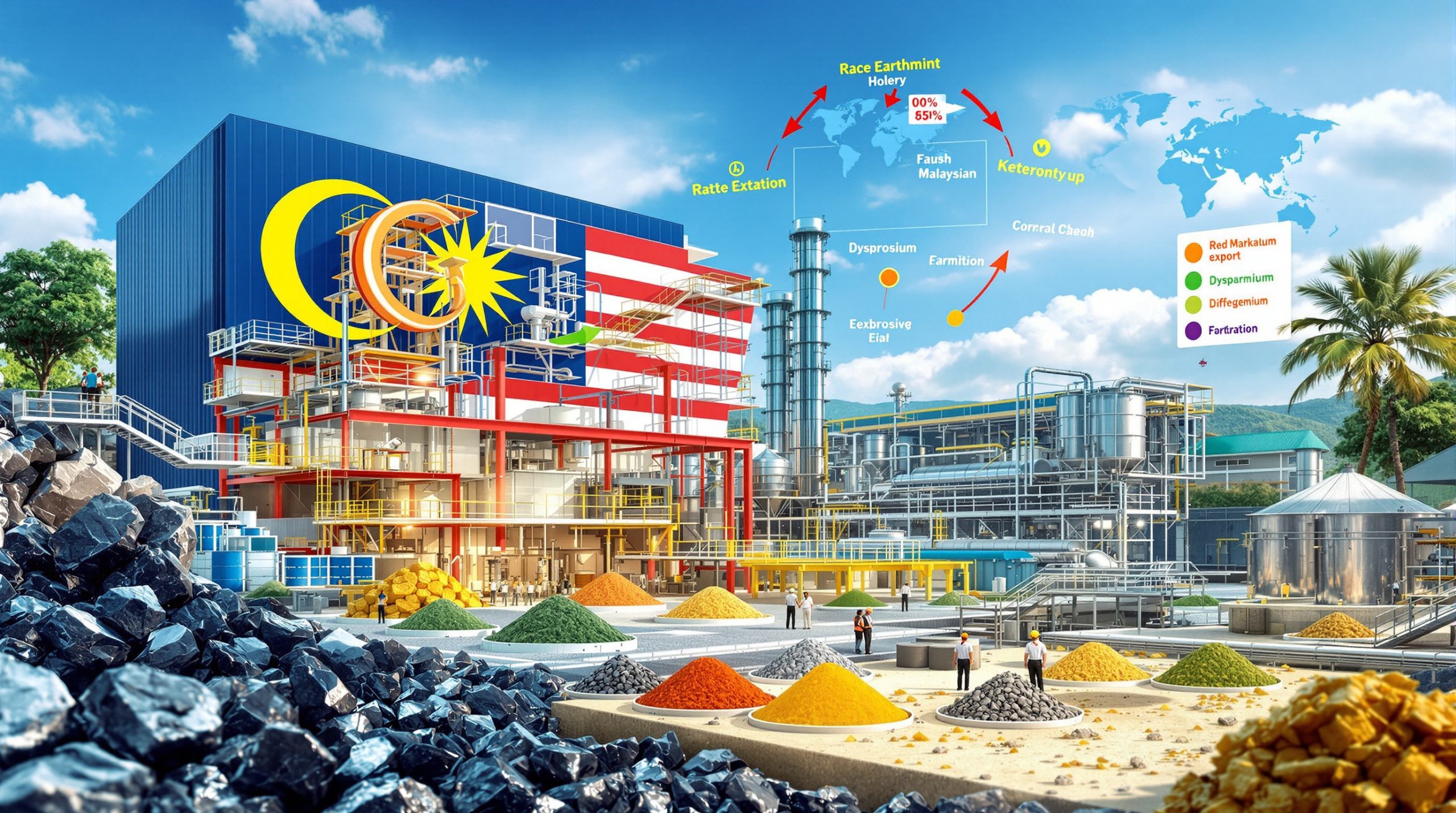Understanding Ruthenium: The Ultra-Rare Metal Behind Modern Technology
Ruthenium, a silvery-gray platinum group metal (PGM), has emerged as a key player in the technological revolution powering our data-driven world. With exceptional hardness and versatility across multiple industries, this overlooked element has become crucial to the expanding artificial intelligence sector. Despite its growing importance, most people remain unaware of this rare metal's critical role in our digital infrastructure.
What is Ruthenium?
Ruthenium is characterized by remarkable durability and adaptability that makes it valuable across electronics, energy storage, and chemical manufacturing applications. This rare element belongs to the platinum family of metals, sharing many properties with its better-known cousins platinum and palladium, but with distinct characteristics that make it uniquely valuable for specialized applications.
As one of the scarcest commercially used metals on Earth, annual global production totals merely 30 tons according to data from SFA (Oxford) Ltd., a respected critical minerals consultancy. This limited supply creates a precarious balance in markets increasingly dependent on ruthenium's unique properties.
"The extreme scarcity of ruthenium makes it particularly vulnerable to supply disruptions, yet its role in enabling modern technology continues to expand," notes industry analysts tracking critical mineral supplies.
Unlike gold or silver that have been known since ancient times, ruthenium was only discovered in 1844 by Russian scientist Karl Klaus, who named it after Ruthenia, the Latin name for Russia. This relative newcomer to the periodic table has quickly become indispensable to modern technology.
Where Does Ruthenium Come From?
Ruthenium extraction presents unique challenges that contribute to its scarcity and price volatility. The metal is primarily obtained as a byproduct of platinum mining operations, with no dedicated ruthenium mines currently in operation. This production model means ruthenium supply depends entirely on the economics of platinum mining rather than responding directly to ruthenium demand.
This dependency creates significant supply vulnerabilities, as noted by Sandeep Kaler, analyst at SFA (Oxford): "Annual supply was just 30 tons last year, and is expected to fall due to lack of investment after many lean years." This supply constraint creates a fundamental market imbalance that's likely to persist.
Most ruthenium comes from South Africa's Bushveld Complex and Russia's Norilsk region, with smaller amounts from North America. The concentration of production in these regions adds geopolitical risk to the ruthenium supply chain that's already strained by limited production.
How is Ruthenium Fueling the AI Boom?
The artificial intelligence revolution depends on massive data processing capabilities, creating unprecedented demand for high-capacity storage solutions. This technological shift has positioned ruthenium as a critical enabler of the AI transformation.
Ruthenium's Critical Role in Data Storage
In hard disk drive (HDD) technology, ruthenium serves an irreplaceable function that enables the staggering data density required for AI applications. The metal appears as an ultra-thin film less than one nanometer thick in modern hard drives, where it facilitates specialized magnetic recording techniques essential for high-capacity storage.
These ruthenium-enhanced HDDs remain the most cost-effective solution for the massive data storage requirements of cloud computing and AI development. The metal's unique magnetic properties allow for precise data recording at nanoscale dimensions, maximizing storage capacity while maintaining affordability.
Sandeep Kaler of SFA (Oxford) explains the connection: "As AI rolls out, as data storage requirements increase, you need a technology which is still cheap, cost-effective and can store large quantities of data. Technology that leans on other elements is still very expensive."
The AI-Driven Demand Surge
Cloud computing expansion directly drives ruthenium consumption, with International Data Corporation (IDC) projecting hard disk sales to increase by 16% in 2025 according to analysis cited by Bloomberg Intelligence. This surge stems from the exponential growth in data center capacity required to support AI development and deployment.
The technical requirements for training advanced AI models are staggering:
- Training a single large language model can require petabytes of storage
- Data centers supporting AI workloads need exabytes of cost-efficient storage
- Enterprise AI adoption is accelerating, creating compounding demand growth
This data explosion makes ruthenium-enhanced HDDs the practical storage backbone of the AI revolution, despite advances in solid-state technology. While solid-state drives (SSDs) offer speed advantages, they cannot match the cost-per-terabyte efficiency of ruthenium-enhanced HDDs for the massive cold storage requirements of AI applications.
Market Performance and Price Dynamics
The essential role of ruthenium in enabling data-hungry technologies has transformed its market performance, creating one of the most dramatic commodity price surges in recent years.
How Has Ruthenium's Price Performed?
Ruthenium has emerged as one of 2025's standout commodity performers, with prices nearly doubling over the past year to reach $800 per ounce according to Johnson Matthey data cited in Bloomberg News. This remarkable price surge has eclipsed even headline-grabbing rallies in precious metals like gold prices analysis.
The current price matches the previous peak from 2021 and approaches the all-time high of $870 established in 2007. The metal's performance is particularly striking when compared to other precious metals over the same period:
| Metal | Current Price (2025) | YoY Price Change |
|---|---|---|
| Ruthenium | $800/oz | +100% |
| Palladium | $1,318/oz | +2.01% |
| Platinum | $1,479/oz | +2.91% |
| Gold | $3,345/oz | -0.27% |
| Silver | $38.31/oz | +0.43% |
This dramatic outperformance highlights the unique supply-demand dynamics affecting the ruthenium market compared to more widely traded metals.
What's Driving the Price Increase?
Several converging factors are fueling ruthenium's price momentum:
-
Structural supply constraints: With annual production of just 30 tons expected to decline further due to historical underinvestment in platinum mining, the supply side faces significant limitations.
-
Technological demand acceleration: AI and cloud computing growth are creating unprecedented demand for data storage solutions that rely on ruthenium.
-
Opaque market structure: Unlike most commodities, ruthenium lacks exchange trading, creating supply chain pressures and price discovery challenges that amplify volatility.
-
Limited substitution options: Alternative technologies remain prohibitively expensive for mass storage applications, keeping ruthenium demand inelastic despite rising prices.
Industry sources report that traders are "scrambling for any supplies" with "even major buyers having trouble sourcing ruthenium" — clear indicators of a market experiencing severe supply tightness.
Supply and Demand Dynamics
The ruthenium market exemplifies the challenges of supplying critical minerals energy transition for rapidly evolving technological applications, with structural limitations creating persistent imbalances.
Current Supply Challenges
The ruthenium market faces significant supply pressures that are intensifying over time. Industry analysts at SFA (Oxford) project the market will enter a deficit in 2026, with demand exceeding available supply. This imbalance stems from years of underinvestment during periods of lower prices, creating a situation where production cannot quickly respond to surging demand.
Several factors compound these supply challenges:
-
Byproduct dependency: As a platinum byproduct, ruthenium production depends on platinum mining economics rather than responding directly to ruthenium demand.
-
Limited geographic sources: Production is concentrated in South Africa and Russia, creating geopolitical vulnerability.
-
Processing complexity: Extracting ruthenium from ore requires sophisticated refining capabilities available at only a few facilities globally.
-
No dedicated mines: Unlike gold or copper, no mines operate primarily for ruthenium extraction, limiting supply flexibility.
These structural constraints make rapid supply expansion challenging even as prices rise, creating persistent market tightness that supports continued price strength.
Supply Chain Complications
Ruthenium's market structure adds another layer of complexity to its supply chain. The metal is not traded on any public exchanges, making price discovery and procurement challenging for even sophisticated buyers. This opaque trading environment creates information asymmetries that further complicate procurement.
Even major technology manufacturers are experiencing difficulties securing adequate supplies, according to market participants cited in Bloomberg News. Traders are scrambling to secure any available material in an increasingly tight market, with spot transactions occurring at significant premiums to published prices.
The absence of futures markets also eliminates hedging options for both producers and consumers, making long-term planning more difficult and increasing price volatility during supply disruptions.
Future Outlook for Ruthenium
The intersection of constrained supply and technology-driven demand growth creates a compelling outlook for ruthenium, though several factors could influence its trajectory.
Will the Price Rally Continue?
Industry experts anticipate continued strong performance in ruthenium prices due to structural supply limitations and growing technological demand. Without significant new investment in production capacity or technological alternatives, the supply-demand imbalance appears likely to persist or even worsen in coming years.
SFA (Oxford) projects a market deficit beginning in 2026, creating conditions for sustained price strength. The lead time for developing new platinum production capacity (which would increase ruthenium byproduct output) typically exceeds five years, meaning even today's high prices won't translate to significant new supply in the near term.
As Sandeep Kaler notes, "Demand for ruthenium will keep rising unless cheaper alternatives can be found" — but such alternatives remain economically unviable for mass deployment in the near term.
Potential Market Risks
Despite the strong outlook, several factors could influence ruthenium's trajectory:
-
Alternative technology development: Advances in storage technology could eventually reduce reliance on ruthenium-enhanced HDDs, though cost parity remains distant.
-
Economic factors: Broader economic slowdowns affecting technology investment could temporarily reduce demand growth.
-
Recycling innovations: Improved ruthenium recovery from electronic waste could increase secondary supply, though current recovery rates remain low.
-
Substitution pressure: Persistently high prices could accelerate research into alternative materials, potentially reducing demand in the longer term.
-
Supply responsiveness: While limited in the near term, higher ruthenium prices could eventually incentivize increased platinum production with corresponding ruthenium byproduct output.
These factors suggest that while the medium-term outlook remains bullish, investors and industry participants should monitor technological developments that could eventually alter demand patterns.
Ruthenium's Applications Beyond AI
While data storage has driven recent demand growth, ruthenium's versatility extends across numerous industrial applications that provide diversified demand sources.
Industrial and Chemical Uses
Beyond data storage, ruthenium serves as an important catalyst in various chemical processes. Its exceptional catalytic properties make it valuable for:
-
Ammonia production: Ruthenium catalysts improve efficiency in ammonia synthesis, a critical process for fertilizer production.
-
Petroleum refining: The metal's catalytic properties enhance hydrogenation reactions in petroleum processing.
-
Electrochemical applications: Ruthenium oxide electrodes are used in chlorine production and other electrochemical processes.
-
Corrosion resistance: Ruthenium alloying enhances the durability of titanium and platinum in extreme industrial environments.
These established industrial applications provide a stable demand foundation that complements the more volatile technology-driven demand from data storage applications.
Emerging Applications
Researchers are exploring ruthenium's potential in next-generation technologies that could further expand its applications:
-
Fuel cell catalysts: Ruthenium shows promise as a more affordable alternative to platinum in certain fuel cell designs, potentially supporting clean energy transitions.
-
Advanced electronics: Beyond storage, ruthenium's electrical properties make it valuable in specialized electronic components.
-
Medical applications: Ruthenium compounds show potential in targeted cancer therapies and as antimicrobial agents.
-
Photovoltaic systems: The metal's light-sensitive properties make it useful in next-generation solar cell designs.
While these emerging applications remain smaller than data storage in volume terms, they represent potential growth vectors that could further tighten the ruthenium market over time.
How to Track the Ruthenium Market
For investors and industry participants, monitoring the ruthenium market presents unique challenges that require specialized approaches.
Challenges in Market Monitoring
Unlike most commodities, ruthenium lacks transparent exchange trading, making price information less accessible. This market opacity creates several monitoring challenges:
-
No futures market: The absence of exchange trading eliminates the price discovery function typically provided by futures markets.
-
Limited pricing sources: Only specialized price reporting agencies publish ruthenium assessments.
-
Transaction privacy: Most ruthenium trades occur privately between producers and end-users, with limited public disclosure.
-
Infrequent transactions: The small market size means transactions occur less frequently than in larger commodity markets.
These factors make ruthenium price data less transparent and timely than for exchange-traded metals like gold or copper.
Key Indicators to Watch
Those interested in tracking ruthenium market developments should monitor several interconnected indicators:
-
Platinum mining production forecasts: As a platinum byproduct, platinum output directly influences ruthenium availability. Reports from major producers like Anglo American Platinum provide valuable insights.
-
Data center and cloud computing expansion plans: Announcements from major cloud providers regarding infrastructure expansion directly impact future ruthenium demand.
-
Hard disk drive manufacturing volumes: Quarterly reports from Western Digital, Seagate, and other manufacturers indicate current demand trends.
-
Technology adoption trends: The balance between HDD and SSD deployment in data centers influences ruthenium consumption patterns.
-
Published price assessments: Johnson Matthey and SFA (Oxford) provide the most reliable ruthenium price assessments, though typically with a delay.
By monitoring these indicators collectively, market participants can develop a more complete picture of ruthenium market conditions despite the limited transparency.
FAQ About Ruthenium and the AI Connection
Why is ruthenium particularly valuable for AI applications?
Ruthenium enables the creation of high-density storage media that can efficiently house the massive datasets required for AI development and deployment. Its unique magnetic properties allow for nanoscale precision in data recording, maximizing storage capacity in a cost-effective manner compared to alternative technologies.
The economics are compelling: ruthenium-enhanced HDDs provide storage at approximately $0.02 per gigabyte compared to $0.10 per gigabyte for SSDs, making them the preferred solution for the enormous "cold storage" requirements of AI systems.
How much ruthenium is typically used in a hard disk drive?
While the exact amounts vary by manufacturer and drive design, ruthenium appears as an ultra-thin film less than a nanometer thick in modern hard drives. Despite these minuscule quantities per unit, the scale of global hard drive production creates significant aggregate demand for the metal.
A typical high-capacity enterprise hard drive might contain mere micrograms of ruthenium, but with global annual HDD production numbering in the hundreds of millions of units, the cumulative demand becomes substantial relative to ruthenium's limited production.
Could ruthenium be replaced with other materials?
Alternative data storage technologies exist but currently remain more expensive for mass deployment. Solid-state drives (SSDs) offer one alternative but cannot yet match the cost-per-terabyte efficiency of ruthenium-enhanced hard disk drives for large-scale storage applications like data centers.
Research into alternative magnetic materials continues, but as Sandeep Kaler of SFA (Oxford) notes, "Technology that leans on other elements is still very expensive." This cost differential maintains ruthenium's position as the most economical solution for bulk data storage despite ongoing research into alternatives.
Is ruthenium considered a critical mineral?
Many jurisdictions classify ruthenium as a critical mineral due to its limited supply, concentration of production, and essential role in strategic technologies. Its importance to data infrastructure and advanced computing makes it particularly significant from a technological security perspective.
The United States, European Union, Japan, and other technologically advanced economies have included platinum group metals like ruthenium on their critical minerals policy lists, recognizing their strategic importance to technological leadership and economic security.
Comparing Ruthenium to Other Technology Metals
Ruthenium's market dynamics differ significantly from other metals used in technology applications, reflecting its unique supply constraints and specialized applications.
| Metal | Current Price (2025) | YoY Price Change | Primary Applications | Annual Production |
|---|---|---|---|---|
| Ruthenium | $800/oz | +100% | Data storage, catalysts | ~30 tons |
| Palladium | $1,318/oz | +2.01% | Automotive catalysts, electronics | ~210 tons |
| Platinum | $1,479/oz | +2.91% | Automotive catalysts, jewelry | ~190 tons |
| Gold | $3,345/oz | -0.27% | Investment, electronics | ~3,000 tons |
| Silver | $38.31/oz | +0.43% | Industrial, investment | ~25,000 tons |
Key Insight: Ruthenium's price performance has significantly outpaced other precious and industrial metals, reflecting its unique supply constraints and growing technological importance in the AI revolution.
The comparison highlights ruthenium's exceptional price performance relative to its peers, driven by the combination of extremely limited supply and growing technological necessity. While gold remains more valuable per ounce, ruthenium's percentage price gain demonstrates the impact of emerging technological demand on previously overlooked metals.
Ready to Spot the Next Major Mining Discovery?
Discover significant ASX mineral announcements before the market reacts with Discovery Alert's proprietary Discovery IQ model, delivering instant notifications on high-potential mining opportunities. Explore why major mineral discoveries can lead to exceptional market returns by visiting Discovery Alert's dedicated discoveries page and position yourself ahead of the market with actionable insights.




